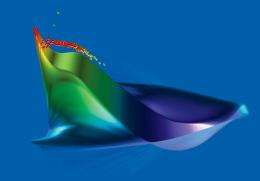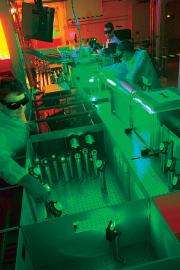Crashing the size barrier

Like surfers on monster waves, electrons can ride waves of plasma to very high energies in a very short distance. Scientists have proven that plasma acceleration works. Now they're developing it as a way to dramatically shrink the size and cost of particle accelerators for science, medicine, industry, and myriad other uses.
Accelerator physicists like to think big: big energies, big speeds, big distances. Over the past 50 years, the most common method of increasing the energy of a particle accelerator has been to increase its size. Yet that tactic is reaching a breaking point. While even higher energies are needed to answer many of science's most pressing questions—such as the origin of mass and the identity of dark matter—simply scaling up the current technology is becoming prohibitively expensive. Scientists need less costly, more efficient means of accelerating particles to ever-greater energies.
"At this point, the current technology is approaching a plateau," says Mark Hogan, a physicist at SLAC National Accelerator Laboratory. "I'm not sure it's wise to just invest more money in bigger devices; we need a technology revolution. Just as electronics were originally based on vacuum tubes and then later on semiconductors, a similar leap is now needed for particle accelerators."
With the type of technological leap Hogan envisions, engineers could build smaller, cheaper, more powerful machines. These machines would not only access new realms of particle physics, but also improve the estimated 17,000 particle accelerators in everyday use around the world—providing radiation treatments for cancer patients, sterilizing food, treating materials used in industry, and disposing of nuclear waste, among dozens of other applications.
The technology that many believe may soon spark such a revolution is called plasma acceleration. First proposed in 1979, it creates a powerful electric field within a plasma—a form of matter similar to a gas—that pulls subatomic particles forward as it pushes them from behind, accelerating them to high energies in a short distance.
Thanks in great part to the American Recovery and Reinvestment Act, commonly known as the stimulus package, researchers at SLAC and at Lawrence Berkeley National Laboratory are poised to take plasma acceleration from concept to reality using two complementary techniques: plasma wakefield acceleration and laser wakefield acceleration.
"I expect the technology revolution to come out of both of these facilities," Hogan says, adding that there is no reason why the two techniques couldn't also be combined in the future.
A short, stunning leap
SLAC researchers shocked the scientific world in 2007 when they announced that they had doubled the energy of electrons streaming out of SLAC's two-mile-long linear accelerator in less than one meter.
They achieved these astounding results by accelerating a tightly packed bunch of electrons to an energy of 42 billion electronvolts in the SLAC linear accelerator, or linac, and then firing it into a 84-centimeter-long chamber full of lithium gas. The resulting jolt of energy transformed the gas into a plasma, a form of matter in which many electrons float free, not bound up in atoms or molecules.
As the front of the electron bunch barreled through the plasma, its strong negative charge repelled these free-floating electrons, which streamed back to create a wake of negative charge. Heavier protons remained near the front of the bunch, giving this region a positive charge.
Electrons in the back of the bunch rode the wake of negative charge like surfers on the crest of a free-electron wave, moving faster and faster toward the protons ahead. The surfing electrons reached energies of up to 85 billion electronvolts—more than double the energy they started with.
"Surfing on plasma waves represents a paradigm shift for particle accelerators that may carry us all the way from cancer therapies to the most fundamental questions we have about what we're made of and who we are," says Thomas Katsouleas of Duke University, who co-led the research effort with Hogan and the late Robert Siemann of SLAC; Chan Joshi of the University of California, Los Angeles; and Patric Muggli of the University of Southern California.
Wanted: better bunches
While the tests proved that plasma wakefield acceleration worked, the resulting spray of electrons was not ideal for many experiments. For instance, to maximize the chance that the electrons in two colliding beams actually hit each other, the electrons must be packed into tight "bunches" with well-defined energies. But in the wakefield tests, the electrons in the back of the bunch zipped ahead, gaining energy, while those in front slowed and lost energy, creating a relatively diffuse stream of electrons with a wide range of energies.
A new project at SLAC, the Facilities for Accelerator Science and Experimental Test Beams, or FACET, will take this proof-of-principle experiment and develop it into a technique for increasing the energy of tightly packed bunches of electrons.
With $14.5 million in stimulus funds, FACET will revamp the first two-thirds of the SLAC linac to create a test bed for research into plasma wakefield acceleration. This section of the linac, which has been shut down since the BaBar experiment stopped taking data in April 2008, will see an infusion of magnets and steering devices, mostly recycled from other projects at the laboratory.
Researchers will first accelerate bunches of electrons to 23 billion electronvolts in the linac. Then, in a soon-to-be-built experimental area eight meters below ground, they'll send pairs of electron bunches into a chamber of lithium gas.
As in the previous round of experiments, the first electron bunch will shock the gas into plasma, creating a wake of free electrons. But this time, a second bunch will arrive at just the right moment to catch the wave of negative charge and ride it to higher energies in a nicely compact bunch.
In the earlier experiments "the majority of particles were not used very efficiently," says FACET project manager Andrei Seryi. "When we're able to create two electron bunches separated by 100 microns with FACET, we'll be able to transfer a major part of the energy from the first bunch to the second bunch. That will be the sweet spot for very efficient acceleration."
If all goes according to plan, FACET will double the energy of this second bunch in less than 40 centimeters, cutting the cost of acceleration to between one-fifth and one-tenth of current levels. Seryi says he expects the FACET collaboration to begin first experiments—and find that sweet spot—in late 2011.
"This is really high-risk, high-reward research," says Hogan, who serves as FACET's chief experimental scientist. "And it is paying off. Things are really getting exciting."

A colossal jump-start
Berkeley Lab, about an hour north of SLAC, has no big linac. But it does have lasers—very, very powerful lasers. Researchers there are working on a complementary technique called laser wakefield acceleration.
"Right now, we have three lasers: Godzilla, TREX, and Chihuahua," says project leader Wim Leemans, who heads Berkeley Lab's Laser Optics and Accelerator Systems Integrated Studies program. "Everyone seems to have very macho names for their lasers, so that last one is a bit of a joke."
Jokes aside, the lasers are no weaklings. The newest one, TREX, operates at 50 trillion watts for a sliver of a second. For comparison, the average stroke of lightning transfers about one trillion watts of power at its peak.
In 2006, Leemans and his team sent their own shock through the science community. Working with researchers from Oxford University in England, the team sent an electric current through a cloud of hydrogen gas confined in a very thin sapphire tube. This jolt turned the gas into plasma, leaving a long channel through the middle. The team then directed an intense laser pulse through that "guiding" channel, creating an electron wake much like the ones in the SLAC experiments. But rather than accelerating electrons that were already moving fast, this wake plucked free electrons from the plasma and accelerated them from zero to one billion electronvolts in just three centimeters.
"This work made people realize laser acceleration could be useful," says Berkeley Lab physicist Cameron Geddes. "Over the past five years, our group demonstrated that with this kind of experiment we could create a beam with a narrow energy spread"—the tightly packed bunches of electrons needed for high-energy physics experiments.
From zero to a billion in nothing flat
Now, with $20 million in stimulus funding, the group will purchase an even stronger laser called the Berkeley Lab Laser Accelerator, or BELLA. With an output of one quadrillion watts, this custom laser will create, for a fraction of a second, an amount of energy equivalent to about 0.5 percent of the total energy striking the Earth from the sun at any given moment. By focusing this extreme power on the plasma, the Berkeley team will increase the size of the wake and accelerate electrons to even higher energies.
BELLA won't be finished for three years, and the Berkeley Lab team is using that time to improve their experimental set-up and techniques using Godzilla, TREX, and Chihuahua as the laser drivers. With these refinements, Leemans says, the team should be able to reach 10 billion electronvolts in just 80 centimeters once BELLA arrives. The next goal will be to stack as many as ten such devices, one after the other, to increase the total acceleration from 10 billion to 100 billion electronvolts.
Both groups have quite a bit of work ahead of them before they prove that plasma acceleration—be it initiated by a particle beam or by a laser—can power the accelerators of tomorrow. But by advancing both plasma wakefield and laser wakefield acceleration techniques, researchers are much more likely to overcome hurdles and make this technical leap.
"I'm very happy that both BELLA and FACET are moving ahead," Leemans says. "SLAC has proven that they can create very high energy levels, while we have demonstrated that we can accelerate a narrow energy bunch. We're working on different parts of the same overall project. The two labs are finding common ground, and learning from one another."
Complementary paths
Each approach has its benefits. The Berkeley Lab method is self-contained, so it could be deployed in environments ranging from hospital basements to particle physics laboratories. The SLAC technology, on the other hand, could be added to existing or future accelerators, providing the "afterburner" needed to propel particles to even greater energies.
Both could also power—or increase the power of—lightsources, the particle accelerators that generate X-rays for research in physics, material science, biology, chemistry, environmental science, and even archaeology. As in particle physics applications, plasma-powered lightsources would be smaller, cheaper, and more powerful than the current technology. Although the concept is still very preliminary, Seryi says plasma acceleration could also be used to upgrade SLAC's Linac Coherent Light Source, the world's brightest X-ray laser. This would double the machine's energy within just 30 centimeters of plasma.
In addition, the technology could power colliders, accelerators that send high-energy particle beams crashing into each other. "I could imagine two possibilities," Seryi says. "We could build an entire collider based on the new technology, once the technology has matured. Or we could use it as a way to increase the energy of existing colliders, building a new lower-energy linear collider with conventional technology, and then, after exploring the physics in that energy range, upgrading it years later with a plasma afterburner to reach very high energies."
Together, the collaborations hope to make the technological leap that will give particle physics and a host of other fields the new accelerating technology they need.
"We have common issues and common physics," Hogan says. "These projects aren't easy, but other heroic efforts were needed to design and then run the current technology. I have no doubt that we'll get there."
Source: symmetry, Fermilab/SLAC, By Kelen Tuttle


















